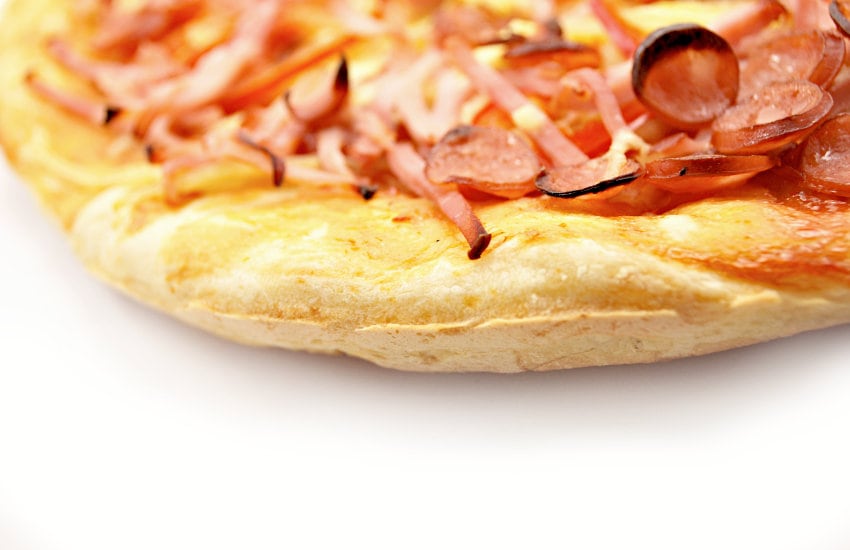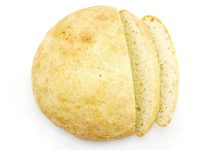Do you really need to search for the best pizza stones and baking steels? The short answer is: yes.
I’m pretty sure you caught on to that since I’m writing an article reviewing the best pizza stones and baking steels. However, there’s so much more to this subject.
The basic idea is this: if you have a home wall oven you can transform into an absolutely fantastic pizza oven by just baking on a stone. Moreover, you can obtain wonderful, delicious results by baking on a pizza stone in a toaster oven or a convection oven.
The process is a bit more complicated than that. After reviewing the best models, I’m going to teach you all there is to baking on a pizza stone.
Portable outdoor ovens, which are not exactly cheap, also utilize a pizza stone as the baking surface. That simple fact just shows you how extremely important and efficient this type of bakeware is.
However, if you feel like you aren’t ready for buying a baking stone/steel, you can also check out my post on the best pizza stone substitutes. You’ll be able to find some nice options there, too.
Contents
Best Pizza Stones and Baking Steels Reviews
 The prices for these best pizza stones and baking steels range from about $30 to almost $100 to a bit over $100.
The prices for these best pizza stones and baking steels range from about $30 to almost $100 to a bit over $100.
These best pizza stones and baking steels cover all budgets but they will last a very long time if you handle them properly. They can be totally worth it.
1. Heritage Pizza Stone, 15 inch – Overall Best Pizza Stone
Cordierite baking stones are indeed some of the best and we’re going to review some round and square models made from cordierite in a bit.
However, as my first recommendation, I want to actually recommend a ceramic pizza stone. In general, ceramic is considered to be less resistant so, they’re not exactly the most popular.
Even so, this 15-inch round stone from Heritage is quite the exception.
It’s one of the most affordable but also quite durable, even if it’s made of ceramic.
That’s because it’s cast from black ceramic and protected by heat resistant coating, which makes it reasonably durable.
Nevertheless, if you drop it, there’s a high chance it will bread in two right there on the floor. But that’s true for cordierite ones, too. Only baking steels are unbreakable no matter how you handle them. But they’re also a lot more expensive.
Moreover, never place a cold pizza stone in a hot oven. That kind of thermal shock will break it. You always have to preheat it in a room temperature oven.
Other things that make Heritage one of the best pizza stones is that it can preheat twice as fast as the others. That’s indeed an advantage, considering that most stones have to be preheat for 30-45 minutes or even an hour.
It’s also non-stick. You’ll need very little flour or cornmeal but it’s still a good idea to use some. Or just bake on parchment paper.
2. Pizzacraft 15″ Square ThermaBond Baking/Pizza Stone
If you like the idea of a 15-inch stone but are set on getting a square one that’s made of cordierite, the Pizzacraft one can be what you’re looking for.
It’s also reasonably priced.
Plus, the 0.59 inches thickness definitely exceeds the average. It’s the thickest pizza stone on this list. I would give it enough time when it comes to preheating it. An hour would be fantastic but the manufacturer actually recommends preheating it for only 30 minutes at 500° F (260° C).
It’s made of 100% all-natural FDA-safe Thermabond material, which is thermal shock resistant. If you don’t want to go all fancy and I don’t, we’ll just say that it’s made of cordierite.
It has a porous surface that allows the moisture to escape, preventing a soggy crust. However, that can make it a bit difficult to clean. That’s why I mostly recommend using parchment paper to prevent the dough from sticking to the stone and to avoid a painful cleaning session.
3. Honey-Can-Do Oven Round Pizza Stone, 16″
This is another cordierite pizza stone but this time you’ll be getting a round model that’s quite big. It’s a 16 inch one, make sure that your oven is big enough for it.
You’ll get delicious pizza but, more than that, it’s perfect for all sorts of pastries and breads without any risk of burning the bottom.
The price is one of the most affordable and the quality is one of the best. That’s a nice combination to have around.
Moreover, one of its top features relies in the fact that this is quite a thick stone, 1/2 inches thick. It can easily perform consecutive bakes.
If you want to bake a few pizzas in a row, just leave it in the oven for 5-10 minutes between baking. It will allow the stone to restore its stored heat levels. It will also give you time to prepare your next pie, roll out the dough, and pack it with cheese and toppings.
To prevent the dough from sticking to the stone, use flour, cornmeal or parchment paper. Just assume that it will stick and don’t try it bare.
You’ll have to wash it thoroughly before using it for the first time. Leave it to dry or dry it with a towel. After that, heat it in the oven for 30 minutes. No smell should be coming off. If there’s any smell, just return it.
4. Geebobo Pizza Stone for Oven and Grill – Best Small Pizza Stone
There’s nothing really extraordinary about the Geebobo Pizza Stone. It’s a cordierite that bakes very well, just like all the other best pizza stones reviewed above.
Well, its 12-inch size is what really stands out. As you saw, most stones, whether they’re round or square, measure 15/16 inches.
However, there are people who are just looking for a smaller, best pizza stone. That’s where Geebobo comes in.
They also have a 10-inch model. They’re both round.
The price is not the cheapest, especially when we consider both the smaller size and the smaller thickness.
It’s 0.35 inches thick. I expected something like that but it goes well with this size. It also means that a 30-minute preheat is more than enough.
5. Top Notch Kitchenware Modular Baking Steel – Affordable Baking Steel
The alternative to cordierite/ceramic baking stones comes in the form of baking steels.
Since they’re made of steel, their main selling point is durability. These easily have the potential of lasting a lifetime and then some.
The Top Notch Kitchenware Modular Baking Steel is not exactly the most exciting baking steel. That title is reserved for the one that I’m going to review immediately after.
However, it’s a perfect example for the best pizza stone that’s made of steel and doesn’t cost a lot. It’s not cheap but neither very expensive. Somewhere in between.
It’s a 13 inch one with a 0.25 inches thickness. So, it’s not thick at all. But it’s a good match for those with smaller ovens.
The fact that it’s thinner also means that you won’t have to preheat it for more than 1 hour. 1 hour preheating time is more than enough.
If you want more baking space and your oven is big enough, you can purchase two and set them side by side.
6. NerdChef Steel Stone – Expensive Baking Steel
The NerdChef Steel Stone is a fantastic piece of bakeware. It’s impressive. First, you’ll notice the very expensive price. It’s the most expensive best pizza stone on this list.
It’s actually a 14.25 x 16 inches baking steel with an impressive 0.50 inches thickness.
This thing is massive and it’s not for people with weak wrists. It weighs 32 pounds. Maneuvering a 32 pounds baking steel is not small feat. I think you should get a pizza peel to make things a bit easier.
An hour and a half is the recommended preheating time.
The NerdChef is amazing for pizza and pita baking but it can also be used for baking artisan breads – just don’t try baking pastries on it. They will totally burn on the bottom.
All in all, this is the type of steel that can satisfy even the most demanding bakers. It will meet all expectations and even maybe wow you a bit.
Plus, there won’t be any weird smells coming from it – that seems to be a problem for some users with a lot of the pizza stones made of ceramic/clay.
The cleaning is pretty simple, just make sure to clean it after every use.
Let it cool down completely in the oven. You can use a dough scraper to remove any food debris. Then, you can wash it with soap and water but don’t let it air dry, it can rust. Dry it completely with a towel every time it gets wet.
7. Lodge P14P3 Cast Iron Baking Pan – Best Pizza Stone Alternative
You might be wandering what’s up with this cast iron baking pan on a list for the best pizza stones and baking steels?
Well, the reason is very simple: the Lodge Cast Iron Baking Pan is fantastic for pizza baking and more.
It highly deserves being among the best pizza stones and baking steels. The Lodge Cast Iron Baking Pan will help anyone get a crispy crust pizza, it’s also easier to use and maintain than a stone, plus there’s no smell.
If you get it on sale, it’s pretty affordable. The full price is quite expensive but it’s also high quality. It’s insanely popular.
The 14 inch diameter is nice and it’s already pre-seasoned with vegetable oil, ready for you to make the most of it.
There are side loop handles so you can easily carry it, very nice addition, considering that it can also be used on the grill.
It also weighs only 9.5 pounds, easy to handle by anyone.
Moreover, it’s very easy to clean. Wash it by hand with dish soap and dry it completely with a towel to avoid rusting and then rub it with vegetable oil.
Being made of cast iron, it will last a lifetime, no concerns there.
It handles temperatures well over 700 degrees, it gets hot incredibly quickly. It will reach 400 degrees in 4 minutes, there’s no reason to preheat it for an hour in the oven like you would do with a stone or baking steel.
Put it in the oven, turn it on, and preheat the Lodge Cast Iron Baking Pan for about 10 to 15 minutes
You can bake back-to-back pizzas.
Once you’re done, turn the oven off and let the pan inside the oven until it’s cooled down.
How to Use a Pizza Stone
- put the stone in the cold oven – if you put it in a hot oven, the thermal shock can crack it
- preheat for at least 45 minutes at 400-500 degrees Fahrenheit
- if you plan on baking multiple pizzas back to back then 1 hr. and a half preheating would be best – the instructions vary with the stone
- once you’re ready to bake, you can sprinkle the stone with cornmeal to prevent the dough from sticking to the stone
- you can also bake on parchment paper or use flour to prevent the dough from sticking to the stone
- once you turn off the oven, leave the stone inside until it has completely cooled off
What is a pizza stone?
Wooden oven pizza is still one of the most delicious things on the planet. However, what do you do when you can’t use a wooden oven?
You go for the second best choice: you use an oven stone for pizza or a baking steel.
It’s the only solution to getting a crispy crust even though it won’t have that rustic flavor.
How does it work?
A stone or a steel radiate intense heat so the crust will get crispy in a brief period of time.
The heat is transferred to the bottom of the stone without lowering the oven temperature.
These baking aids don’t make the oven hotter, they store the heat, concentrate it – that’s why the pizza/bread is baked directly on the surface.
They can also be used on a grill but that’s not true for all so, make sure of that.
It’s pretty fascinating if you’re interested in baking amazingly delicious pizza at home.
How to Take Care of a Pizza Stone
There are a few tips that you must follow in order to prevent your pizza stone from breaking.
If you follow these instructions, you’ll be able to use it for many years to come:
- place the stone in a cold oven, never in a hot oven
- it’s best not to wash it but if you do wash it, dry it completely and use only water, no soap
- the baking steel can be washed and even scraped with a dough scraper, just make sure to dry it thoroughly with a towel to prevent rusting
- never use oil on a pizza stone
- once again, I just want to repeat this, don’t oil your stone
- let it cool in the oven once you turn it off
- handling it too much can weaken the stone, it’s best to keep it in the oven all the time
- don’t cut the pizza on the stone
Pizza Stones vs Baking Steels
You might have noticed that I’ve mentioned both pizza stones and baking steels. Some of you might not even know what a baking steel is but it’s exactly what the name suggests.
Baking steels are rectangular/round sheets made entirely of steel.
Traditional pizza stones are made of ceramic or cordierite (a highly durable type of ceramic).
You bake the pizza directly on them just like you would do on an oven stone for pizza.
Why baking steels are awesome
- Andris Lagsdin is actually the inventor of the baking steel, the company is called exactly that – Baking Steel
- there are other manufacturers who have launched their own steels
- the baking steel is a favorite tool for many chefs
- steel conducts heat a lot faster and more evenly, it gets hotter than a stone and that’s why they’re so great for pizza baking, for getting the perfect crispy outer crust combined with the perfectly-cooked tender crust underneath that can support multiple toppings
- thin-crust pizzas are done in a few minutes
- it’s perfect for pita bread, as well
- being made of steel means that they won’t break, they’re indestructible but still require maintenance, pretty much like a cast-iron skillet, if you have experience with those you’ll know what I’m talking about
- they can rust, especially in humid weather
- to prevent rusting, you need to season it
- being made of steel, they’re also quite heavy, it’s not easy to move them in and out of the oven
- stones break after a few years, it depends on how well you handle them, they’re a few tips to follow if you don’t want your stone to crack too soon
- pizza stones are a lot cheaper, they’re the most cost-effective, baking steels are quite expensive for the average buyer
How to Choose the Best Pizza Stones and Baking Steels
When it comes to choosing the best pizza stones and baking steels there are a few things that you should keep in mind.
Materials
There are 3 materials to choose from: ceramic pizza stones, cordierite stones, and baking steel.
The cheapest best pizza stones are made of ceramic and the most expensive are baking steels.
Cordierite stones are extremely durable. Cordierite is a material that handles extreme temperatures without a problem or a crack (going from a low temperature to a high temperature), unlike ceramic stones, which have to be handled with more care if you don’t want them to break.
A porous stone is better because it allows moisture to escape from the crust, it won’t turn soggy.
The ceramic and cordierite ones can handle not only pizza but also breads (except breads with lot of sugar, they can burn), pastries, pie baking, and so on.
However, the baking steel is mostly for pizza baking and certain breads – since it transfers so much heat, it will blacken the bottom of pastries.
Price
If you’re just casually baking and you are just getting into things and you don’t want to spend too much money in the beginning then a ceramic can be the best pizza stone for you.
But if you won’t settle for anything other than the actual best, regardless of the cost (which is pretty high, on average about $100) then the baking steel is the way to go.
Neither is the same as using a brick oven but the results are pretty close for all 3 materials.
Read the instructions that come with a pizza stone carefully and follow them precisely.
Preheat them
Whichever model you might end up buying, all require a high level temperature, they need to be preheated for a long time starting from 45 minutes up to 2 hours – it depends on the thickness of the stone and it also depends how many pizzas you plan on making in a row.
As you can see, these baking tools require quite a bit of energy to heat them up.
Shape
The size is important – there still needs to be some airflow around the stone, about 1-inch between the stone and oven walls is perfect.
There are two shapes to choose from: rectangular and round.
The rectangular shape is prevalent and it offers plenty of space for maneuvering.
Well, if you have a tiny oven, a round stone would be the best option.
Baking steels are the heaviest and the most difficult to move around, they are usually kept in the oven permanently.
Thickness
There are different options here as well.
Pizza stones and baking steels start from 1/4 inch thick, some are 3/8 inch thick, up to 1/2 inch thick or even 3/4 inch thick.
The thicker the stone the longer it will take to preheat, it will make your kitchen very hot, it’s good to have an air conditioner around, especially in the summer.
In the case of back-to-back baking, if you have a slightly less thick stone or baking steel just let it heat again for 5-10 minutes, the high heat level will be restored, and then it can be used efficiently again – it’s also a good idea to preheat it for 1.5 hours instead of 1 hour.
If you’re keeping all that in mind, the choice won’t seem so difficult.
I’ve also reviewed what I consider to be some of the best pizza stones and baking steels, that’s a very good place to start, it will give you a clear idea about what’s on the market.
With all that’s been written in this post, in the end, what do you think? Are the best pizza stones still preferable to baking steels or, maybe, you don’t need either?




